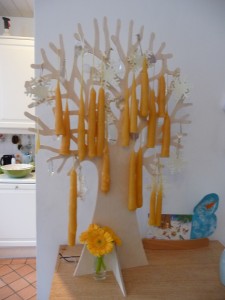This weekend we visited Eise’s brother Victor and his family in Bloemendaal. The good news was that we didn’t take Lotte, our dog, with us, so we were able to use public transportation. We bought a NS Voordeelurenabonnement, which gives a 40% discount (on all trains in weekends and on trains after 9:00 AM on week days). Hopefully this will stimulate us to take the train more often this year! This will be a major bottleneck, I’m afraid, since taking the train is about twice as expensive as the fuel it takes to go by car (with the two of us). We had to choose who of us would buy the Voordeelurenabonnement (the pass allows the owner plus 3 others to travel with a discount, so one pass is sufficient if we travel together). We figured that Eise would probably use the train on his own more often, so he bought the pass.
We had a really nice weekend and finally spent some decent time with Eise’s nephews. And we had a very sustainable weekend too! Maaike, Victor’s girlfriend is fully into macrobiotic cooking, so we ate very healthy and very organic food! We brought a candle-making set as a present (beeswax candles, of course, paraffin is terribly unsustainable since its made of crude oil) so we made a huge amount of strange-looking candles (making candles isn’t that easy!). I was slightly tempted in a shoe store (Victor needed new shoes), where they had really cool and warm woolen slippers (something like these, but in bright pink) in my size for less than half of the price. But I didn’t need new slippers. So I didn’t buy them. Actually, it really was that easy! And furthermore we did mostly consumeless and sustainable stuff (feeding deer, visiting gnomes, etc.).
The coming few weeks I am home alone, so I have to cook for myself (I have to admit, Eise does most of the cooking, and usually I don’t take the trouble to cook a full meal when I’m home alone). Today that was no problem because I didn’t go to Leuven but to Hasselt so I was home earlier than usual and had plenty of time to cook.
One final thing worth mentioning is that I participated in a biweekly meeting at work via Skype so I did not have to travel to Leuven. Not a bad experience actually. With a little bit of microphone aiming by my colleagues I could hear everything quite well and we lost connection only once.
..









